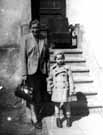
|
|
|

|

|

|

|
|
Click on an image to see a larger, more detailed picture.
|
|
|
|
|
| 1943: Death and Resistance |

|
pg. 491 |

|
|
|
|
| |
 In a family portrait reflecting happier times, Leone Biondi and Virginia Piperno are photographed with three of their six children. October 1943 marked a new stage in German control over Italian affairs following the German occupation of northern Italy. Orders were issued to round up and deport the Jews of Rome, and on October 18 approximately 1000 were sent to Auschwitz. Thanks to the intervention of their Italian friends and neighbors, many Jews were able to hide and to escape capture, some in Catholic churches and monasteries. The Biondis were not so fortunate; the entire family perished at Auschwitz.
In a family portrait reflecting happier times, Leone Biondi and Virginia Piperno are photographed with three of their six children. October 1943 marked a new stage in German control over Italian affairs following the German occupation of northern Italy. Orders were issued to round up and deport the Jews of Rome, and on October 18 approximately 1000 were sent to Auschwitz. Thanks to the intervention of their Italian friends and neighbors, many Jews were able to hide and to escape capture, some in Catholic churches and monasteries. The Biondis were not so fortunate; the entire family perished at Auschwitz.
Photo: Fondazione Centro Di Documentatzione Ebraica Contemproranea / United States Holocaust Memorial Museum Photo Archive
|
 Gertruda Babilinska worked for 15 years for a Jewish family. She is shown here with one of the family's children, Michael Stolovitzky. Babilinska refused to abandon the family after the onset of the German occupation. After Mr. Stolovitzky was shipped to Auschwitz and his daughter died, Bablinska helped Mrs. Stolovitzky and Michael escape, first to Warsaw and then to Vilna. There, she rented an apartment in which she hid Michael. Because Michael's mother also died, Babilinska was responsible for Michael's well-being after the war. The pair emigrated to Israel, where Bablinska provided him with a Jewish upbringing.
Gertruda Babilinska worked for 15 years for a Jewish family. She is shown here with one of the family's children, Michael Stolovitzky. Babilinska refused to abandon the family after the onset of the German occupation. After Mr. Stolovitzky was shipped to Auschwitz and his daughter died, Bablinska helped Mrs. Stolovitzky and Michael escape, first to Warsaw and then to Vilna. There, she rented an apartment in which she hid Michael. Because Michael's mother also died, Babilinska was responsible for Michael's well-being after the war. The pair emigrated to Israel, where Bablinska provided him with a Jewish upbringing.
Photo: Gay Block and Malka Drucker
|
 While Jewish leaders in the Italian cities of Florence and Venice warned Jews to go into hiding, leaders in Rome reacted slowly to the news of possible deportations. Lists and addresses were not destroyed, leaving many families vulnerable to immediate capture. Among those deported were Franza and Enrica Spizzichino, ages seven and ten, respectively, who pose here on a bicycle in a Roman piazza. The girls, their parents, and their brother Mario were hunted down and deported to Auschwitz, where they were killed upon arrival.
While Jewish leaders in the Italian cities of Florence and Venice warned Jews to go into hiding, leaders in Rome reacted slowly to the news of possible deportations. Lists and addresses were not destroyed, leaving many families vulnerable to immediate capture. Among those deported were Franza and Enrica Spizzichino, ages seven and ten, respectively, who pose here on a bicycle in a Roman piazza. The girls, their parents, and their brother Mario were hunted down and deported to Auschwitz, where they were killed upon arrival.
Photo: Fondazione Centro Di Documentatzione Ebraica Contemproranea / United States Holocaust Memorial Museum Photo Archive
|
|

|

|

|

|
 October 17, 1943: German Ambassador to the Vatican Ernst von Weizsäcker writes to the German Foreign Ministry that the College of Cardinals has been "particularly dismayed" since the roundup of Jews in Rome is occurring "below the very windows of the Pope." He notes that the Pope continues to do everything he can "not to burden relations with the German government and German agencies in Rome."
October 17, 1943: German Ambassador to the Vatican Ernst von Weizsäcker writes to the German Foreign Ministry that the College of Cardinals has been "particularly dismayed" since the roundup of Jews in Rome is occurring "below the very windows of the Pope." He notes that the Pope continues to do everything he can "not to burden relations with the German government and German agencies in Rome."
|
 October 20, 1943: The United Nations War Crimes Commission is established; See October 26, 1943.
October 20, 1943: The United Nations War Crimes Commission is established; See October 26, 1943.
|
 October 21, 1943: During the final Aktion in Minsk, Belorussia, about 2000 Jews are murdered at Maly Trostinets.
October 21, 1943: During the final Aktion in Minsk, Belorussia, about 2000 Jews are murdered at Maly Trostinets.
|
 October 23, 1943: Eighteen hundred Polish Jews formerly held at Bergen-Belsen, Germany, arrive at Auschwitz, where the women revolt outside the gas chambers, killing one SS guard and wounding two. SS reinforcements use gas grenades and machine-gun fire to subdue and kill the resisters.
October 23, 1943: Eighteen hundred Polish Jews formerly held at Bergen-Belsen, Germany, arrive at Auschwitz, where the women revolt outside the gas chambers, killing one SS guard and wounding two. SS reinforcements use gas grenades and machine-gun fire to subdue and kill the resisters.
|
|
|
|
|
| 1943: Death and Resistance |

|
pg. 491 |

|
|
The Holocaust Chronicle
© 2009 Publications International, Ltd.
|
|
